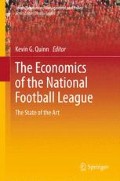Abstract
The NFL is clearly one of the most successful sports leagues in the world. The value of the franchises and the amount of consumer surplus generated illustrate this fact. Over the past 2 decades profits have dramatically increased. Forbes estimates that in 2010 the 32 teams combined are worth over $32 billion dollars. Media contracts have been growing at a very rapid pace and bigger stadiums are being built, as evidenced in Dallas and New York.
Access this chapter
Tax calculation will be finalised at checkout
Purchases are for personal use only
Notes
- 1.
Since Forbes estimates the 2010 value of the Washington Redskins to be $1.55 billion, the nominal yearly return over 83 years is 28.6%.
- 2.
Revenue and cost data is available from 1990 to 2009, which correspond to the franchise values which are available from 1991 to 2010.
- 3.
In looking at the Packer’s Income Statements from 1997 to 2009, net income averages about 75% of profit from operations.
- 4.
FCI is from teammarketingreport.com, and includes four tickets and various concession and parking prices.
References
Alexander D, Kern W (2004) The economic determinants of professional sports franchise values. J Sports Econ 5(1):51–66
Alexander DL, Kern W, Neil J (2000) Valuing the consumption benefits from professional sports franchises and facilities. J Urban Econ 48(2):321–337
Baade RA, Dye RF (1990) The impact of stadiums and professional sports on metropolitan area development. Growth Change 12:1–13
Baade RA, Matheson VA (2000) An assessment of the economic impact of the American football championship, the super bowl, on host communities. Refl Persp Écon 39:35–46
Baade RA, Bauman R, Matheson VA (2008) Selling the game: estimating the economic impact of professional sports through taxable sales. South Econ J 74(3):794–810
Badenhausen K, Ozanian MK, Settimi C (2009) Recession tackles NFL Team values, www.Forbes.com retrieved at http://www.forbes.com/2009/09/02/nfl-pro-football-business-sportsmoney-football-values-09-values.html. Accessed 1 Nov 2010
Carlino G, Coulson NE (2004) Compensating differentials and the social benefits of the NFL. J Urban Econ 56:25–50
Carlino G, Coulson NE (2006) Compensating differentials and the social benefit of the NFL: reply. J Urban Econ 60(1):132–138
Coates D, Humphreys B (1999) The growth effects of sports franchises, stadia, and arenas. J Policy Anal Manage 18:601–624
Coates D, Humphreys BR (2002) The economic impact of postseason play in professional sports. J Sports Econ 3:291–299
Coates D, Humphreys BR (2003) The effect of professional sports on earnings and employment in the services and retail sectors in US cities. Region Sci Urban Econ 33:175–198
Coates D, Humphreys B, Zimbalist A (2006) Compensating differentials and the social benefits of the NFL: a comment. J Urban Econ 60(1):124–131
Davis M, End C (2010) A winning proposition: the economic impact of successful national football league franchises. Econ Inq 48(1):39–50
Fenn AJ, Crooker JR (2009) Estimating local welfare generated by an NFL team under credible threat of relocation. South Econ J 76(1):198–223
Fort R (2006) The value of major league baseball ownership. Int J Sport Finance 1(1):3–8
Humphreys B, Mondello M (2008) Determinants of franchise values in North American professional sports leagues: evidence from a hedonic price model. Int J Sport Finance 3(2):98–105
Johnson B, Mondello MJ, Whitehead JC (2007) The value of public goods generated by a National Football League team. J Sports Manage 21(1):129–136
Matheson VA (2006) Contrary evidence on the impact of the super bowl on the victorious city. J Sports Econ 6(4):420–428
Matheson VA, Baade RA (2006) Padding required: assessing the economic impact of the super bowl. Eur Sports Manage Q 6(4):353–374
Miller P (2007) Private financing and sports franchise values: the case of major league baseball. J Sports Econ 8(5):449–467
Noll RG, Zimbalist A (1997) Sports, jobs and taxes: the economic impact of sports teams and stadiums. Brookings Institution, Washington
Ostfield A (1995) Seat license revenue in the National Football League: shareable or not? Seton Hall J Sport Law 5:599–610
Owen J (2003) The stadium game: cities versus teams. J Sports Econ 4(3):183–202
Quirk J, Fort RD (1992) Pay dirt: the business of professional team sports. Princeton University Press, Princeton
Rappaport J, Wilkerson C (2001) What are the benefits of hosting a major league sports franchise? Econ Rev (Fed Reserve Bank Kansas City) 86(1):55–86
Rosentraub MS, Swindell D, Tsvetkova S (2009) Justifying public investments in sports: measuring the intangibles. J Tourism 9(2):133–159
Salaga S, Winfree JA (2010) Secondary market demand for national football league personal seat licenses and season ticket rights, Working Paper
Sandomir R (2009) A Texas-size stadium. New York Times. http://www.nytimes.com/2009/07/17/sports/football/17cowboys.html. Accessed 1 Nov 2010
Sandomir R (2011) N.F.L. finances, as seen through Packers’ records. New York Times. http://www.nytimes.com/2011/01/28/sports/football/28packers.html. Accessed 2 Aug 2011
Author information
Authors and Affiliations
Corresponding author
Editor information
Editors and Affiliations
Rights and permissions
Copyright information
© 2012 Springer Science+Business Media, LLC
About this chapter
Cite this chapter
Winfree, J. (2012). NFL Franchise Values, Locations, and Stadium Economics. In: Quinn, K. (eds) The Economics of the National Football League. Sports Economics, Management and Policy, vol 2. Springer, New York, NY. https://doi.org/10.1007/978-1-4419-6290-4_3
Download citation
DOI: https://doi.org/10.1007/978-1-4419-6290-4_3
Published:
Publisher Name: Springer, New York, NY
Print ISBN: 978-1-4419-6289-8
Online ISBN: 978-1-4419-6290-4
eBook Packages: Business and EconomicsEconomics and Finance (R0)

